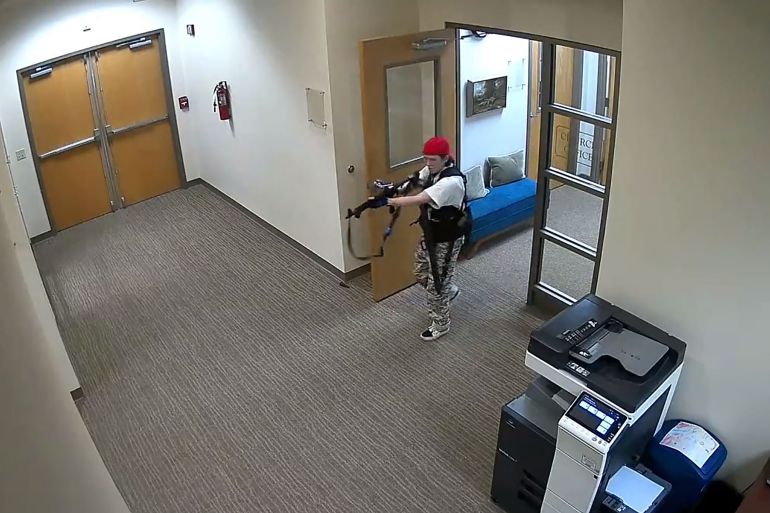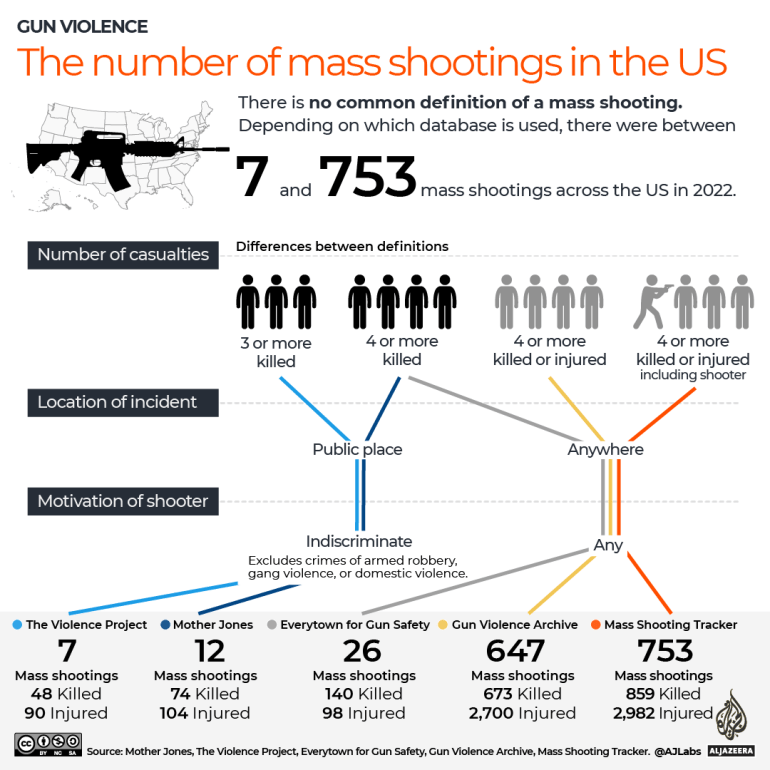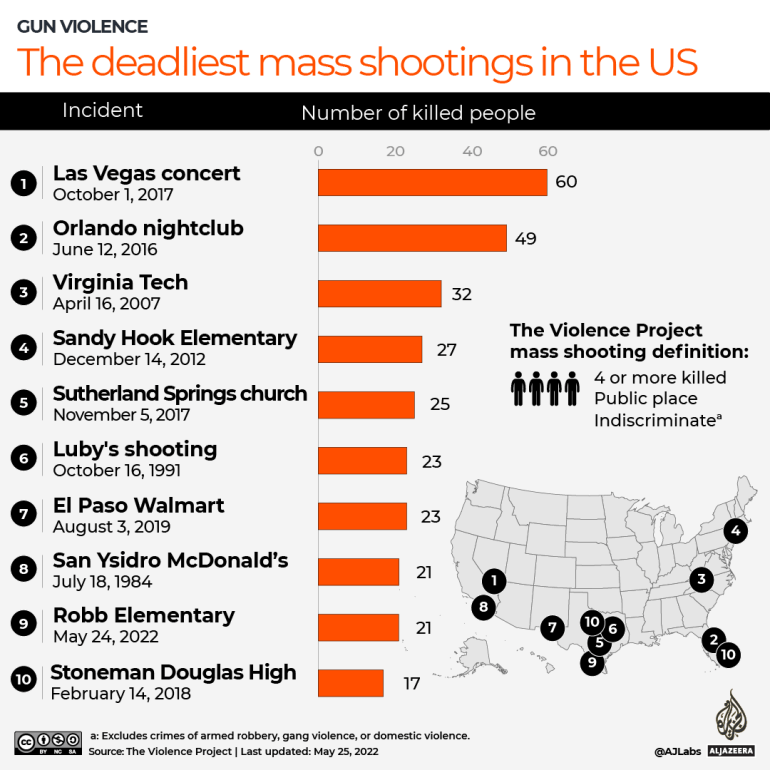US lawmakers banned assault weapons in 1994. Why can’t they now?
Calls to ban assault weapons regularly follow mass shootings but the effort remains stalled in the US Congress.

Washington, DC – Images of an attacker stalking a school, workplace and other public areas while wielding a high-powered firearm have become common in the wake of mass shootings in the United States.
The assault weapons often draw comparisons to combatants in war and they have become emblematic of what many say is an epidemic of gun violence in the country.
Keep reading
list of 3 itemsTimeline: US mass shootings in 2023
Gunman in racist mass shooting in Buffalo gets life in prison
Now, as gun control advocates, Democrats and US President Joe Biden push for a federal ban on assault weapons, a similar, decades-old prohibition looms large – evidence to some that US lawmakers have the power to act to try to stem deadly shootings.
“Ban assault weapons now. Once and for all,” Biden said in February, in one of his many appeals to the US Congress since taking office.
“I led the fight to do that in 1994. Let’s finish the job and ban these assault weapons again.”
Ban assault weapons.
Require safe storage of firearms.
Require background checks for all gun sales.
Eliminate gun manufacturers’ immunity from liability.We can and must do these things now.
— Joe Biden (@JoeBiden) April 17, 2023
But observers question whether the decades-old ban – which was passed in 1994 and expired 10 years later – can be replicated, especially as assault weapons have taken on a newfound political significance.
In the years since the 1994 prohibition, assault weapons increasingly became a “political symbol” among powerful segments of the gun community and Republican politicians, said Robert Spitzer, an expert on US gun policy.
So while polls show “there continues to be majority support for restriction on assault weapons” in the US, Spitzer told Al Jazeera, “the marketing of the weapon and its political implications have been viewed as kind of the front line of the American gun battle”.
The 1994 legislation
In many ways, the 1994 legislation represents a relic of the past.
Passed with bipartisan support, it came into force when such cooperation between the two major parties in US politics was generally more common, said Gregg Lee Carter, a professor of sociology at Bryant University and a gun violence and policy expert.
Gun safety also had not completely evolved into the modern wedge issue it is today, Carter told Al Jazeera, as evidenced by the passage of a preceding 1993 law that mandated federal background checks for firearm purchases.
Summing up his support for the 1994 ban, then-Republican Representative Henry Hyde, a staunch conservative, said: “They have no sporting use. They have no target use. Their only purpose is killing people and I don’t see a justification for it.”
Still, the issue was fraught, with former Representative Fred Upton recounting to the New York Times in 2019: “When I voted for it, I actually had to have police protection for six months … It was really nasty.”

The 1994 legislation was passed as part of an omnibus, anti-crime package that, while controversial, came amid concerns over the role high-powered firearms were playing in the US’s crack cocaine epidemic in the 1980s and early 1990s, Carter explained.
By 2004, when the federal assault weapon ban expired, the Democratic and Republican parties had already become more entrenched, with Republicans hewing closer to pro-gun interests.
This was fuelled in part by pressure from the National Rifle Association (NRA), a gun lobby group whose political wing had become a more influential player, despite weakening significantly in recent years.
And aside from a relatively modest gun reform package passed last year with bipartisan support, Carter said attempts to pass federal gun control legislation are consistently met with roadblocks from Republican legislators.
“There’s really been a cultural shift in the Republican Party,” he said. “And there’s just essentially no discussion.”
What is an assault weapon?
Meanwhile, the term “assault weapon” has no official definition under current US federal law and itself carries political baggage.
For gun control advocates and analysts, the term has generally been applied to certain high-powered semi-automatic rifles and pistols.
Biden has most recently thrown his weight behind an assault weapons ban introduced by congressional Democrats in January, which names 205 weapons that would be outlawed – such as AK47-style rifles, semi-automatic rifles and AR-15s – while explicitly exempting 2,200 other guns.
That bill further defines “assault weapons” as rifles and pistols that have the capacity to use a detachable ammunition feeding device, as well as having one or more particular features, including a collapsable stock, a pistol grip or a threaded barrel, which can allow for certain attachments to be added.
The 1994 legislation took a similar tact, naming 19 firearm models explicitly, while also giving a broad definition of the weapon. The 1994 legislation also barred the sale of high-capacity magazines, which can be attached to firearms to allow a gunman to fire dozens of shots before reloading. The proposed 2023 ban includes this prohibition, as well.
The gun industry and influential lobby groups including the NRA have generally rejected that the “assault weapon” title applies to any guns currently being sold legally in the US.
They have argued it only applies to fully automatic weapons, which fire multiple rounds with a single pull of the trigger and were outlawed in the US in 1968, and not the semi-automatic firearms – which fire only one bullet per trigger pull while automatically loading the next bullet – that remain legal today.
Use in mass killings
The focus on assault weapons – and efforts to ban them at the federal level – comes as these firearms have been disproportionately used in mass shootings compared with other categories of gun crimes, according to The Violence Project, a US non-profit research group.
The organisation, which defines a mass shooting as an incident in which four or more people were killed in a public or semi-public location, said what it classifies as assault weapons were used in 52 of the 189 such attacks since 1966.
But they have been used in more high-fatality incidents: Seventeen of the 33 deadliest mass shootings in the US since 1966 were carried out with assault weapons, the group’s analysis showed.
A separate count by Everytown for Gun Safety of mass shootings involving four or more victim fatalities – regardless of where they took place – found assault weapons had been used in nine of the 10 deadliest of those attacks between 2015 and 2022. The organisation recorded 175 mass shootings with four or more deaths during that period.

The Violence Project’s data also found that in the last 10 years, the weapons were used in all seven mass attacks in which 14 or more people were killed – a phenomenon experts attribute to the power of the weapons.
“A nine-millimetre handgun is devastating, but it can’t hold a candle stick to the speed and the size of that .225 calibre bullet that comes out of an AR-15,” Carter said.
“When it enters you, the impact creates a reverberation that just turns the bone and the meat and the organs into hamburger.”
Lack of data
While Biden continues to invoke the 1994 ban in an effort to get Congress to enact a new prohibition, stressing that such a measure will help reduce gun violence, experts say it remains difficult to determine what direct effect the decades-old law had on mass shootings.
A 2019 study conducted by injury epidemiologists and trauma surgeons found that the risk of someone dying in a mass shooting was 70 percent lower when the 1994 ban was in place, one of the report’s authors, trauma surgeon Michael Klein, wrote in a recent article.
The study noted, however, that the drop could not be definitively linked to the ban alone as it accompanied an overall reduction in crime attributable to several other possible factors.
Andrew Morral, the director of the National Collaborative on Gun Violence Research at the RAND Corporation, which conducts regular reviews of gun-related studies, said “there hasn’t been research that says one way or the other whether the federal assault weapons ban or any state assault weapons bans have had their intended effect”.
Nine states and the District of Columbia have passed various measures that prohibit the sale or transfer of assault weapons but those bans only apply in those jurisdictions.
“That’s not to say they don’t [work]. It just means that the research that’s been done can’t draw a conclusion on that question,” Morral told Al Jazeera, adding, however, that there is “limited evidence that bans on large capacity magazines … may, in fact, reduce mass shootings”.
The circumstances surrounding mass shootings are difficult to study for several reasons. For one, while such attacks are arrestingly more common in the US than in other developed countries, they are still statistically rare.
The Gun Violence Archive, which employs one of the widest definitions of what constitutes a mass shooting, tracked 513 mass shooting fatalities in 2020 – a year when more than 45,000 people died from gun-related injuries.
Yet, regardless of the metric used, almost all trackers show that the number of mass shootings has increased significantly since the 1994 ban expired. Morral also said that assault weapons have been disproportionately used “in the highest casualty” incidents in recent years.
“And that suggests that they may be attractive to people who are intent on killing a large number of people, for obvious reasons.”
‘Political symbolism’
Another hurdle for US legislators today is the fact that assault rifles – often marketed as modern sporting rifles – have skyrocketed in popularity since the 1994 ban expired, with at least 24 million in circulation as of 2022, according to the National Shooting Sports Foundation.
Polling data from The Washington Post and Ipsos found that one in 20 US adults – 16 million people – owned at least one AR-15-style rifle as of 2023.
That raises a difficult question over how effective a ban on new sales and manufacturing would be, especially if it allowed residents to continue to own assault rifles bought before the ban went into effect, as the 1994 ban did.
“There are millions of these in circulation,” Bryant University’s Carter said. “The toothpaste is out of the tube.”
At the same time, the cultural embrace of these types of weapons among some Republicans puts a ban farther from reach from gun reform advocates, Spitzer added.
The style of weapon has become a common political token for legislators seeking to show their support for gun rights.
In February, Republican Representative Andrew Clyde touted that he was handing out lapel pins shaped like assault weapons to his House of Representatives colleagues. Republican Representative Barry Moore introduced legislation to make the AR-15 style rifle “the National Gun of the United States”.
And in the wake of a deadly school shooting in Nashville, Tennessee in March, the area’s congressman, Republican Andy Ogles, also faced criticism for a Christmas photo showing him and his family holding assault rifles.
That has had a knock-on effect within the gun control community, who may see measures like red flag laws, expanded background checks or raising the minimum age for gun buyers as more politically attainable, said Spitzer.
“There’s a sense that the prospect of enacting those types of laws is greater than enacting a new federal assault weapons ban,” he said.